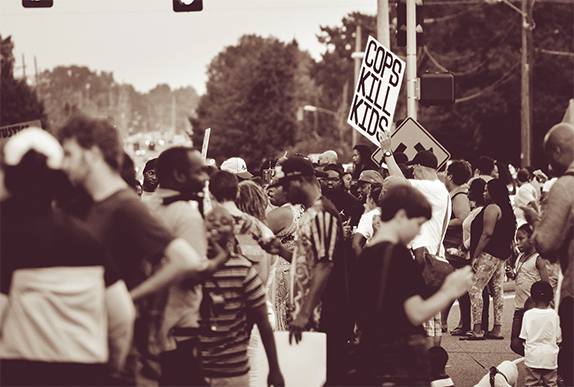
By Kent Patterson
The British, Mexican and other international media once again shined a spotlight on U.S. policing practices and widespread allegations of brutality in recent days. The focus this time was on the four-day Ferguson October action in the St. Louis, Missouri area, where thousands assembled to demand justice for African-American teen Mike Brown and other victims of police shootings.
“We are here to bring peace, to bring restoration, to lift our banners in the name of those who’ve been sacrificed,” said Montague Simmons, organizer for the St. Louis-based Organization for Black Struggle.
Among the events was an October 11 demonstration by dozens of people outside Busch Stadium prior to the opening pitch of the St. Louis Cardinals and San Francisco Giants game for the National League pennant. The following day, at least 17 people were reported arrested after conducting a sit-in at a convenience store
Actions in solidarity with Ferguson October were also held in different parts of the United States, including New Mexico.
Ivy Whisper, a New Mexico member of Whites against Racial Inequality, told FNS that white people must support “empowering the new civil rights struggle.” Whisper said activists plan on constructing a “permanent” memorial to Mike Brown in Santa Fe’s Rose Park.
Albuquerque activists staged two protests on Saturday, October 11. At one demonstration held on the corner of San Mateo Blvd. and Central Avenue, members of ABQ Justice and the Answer Coalition, relatives of shooting victims and others held up signs, passed out “know your rights” literature, gave away burritos, sodas and cookies and spoke to passersby about issues with law enforcement.
Long before Ferguson, the citizen activists were protesting the fatal shootings of 27 people by the Albuquerque Police Department (APD) since 2010 and other instances of alleged law enforcement violence.
“Albuquerque Stands with Ferguson” and “Hands Up” were among the messages flashed at motorists passing by on Central Avenue. Barbara Grothus carried a cardboard cut-out with an image of an assault rifle that read “Armed 4 War No AR 15s APD,” in reference to the local police department’s plans to purchase 350 of the guns.
Protesters carrying cardboard AR 15s were recently ejected from an Albuquerque hotel when the group was protesting a national police shooting competition, because staff said the cut-outs would “scare” children, Grothus said.
Dinah Vargas, who traveled to Ferguson last August after mass protests against unarmed Mike Brown’s killing erupted, said she detected similarities between Albuquerque and Ferguson, both of which she termed “broken cities.”
“The parallels we saw were mistrust of the government, mistrust for the police officers and a disregard for human rights and human life,” Vargas said. “Police violence is a characteristic of the corruption. Our government allows this police violence because they themselves are corrupt. If our government is lawless, I don’t expect the police to uphold law and order.”
Vargas said she heard many stories from Ferguson residents that were never transmitted in the media, but felt “a lot of love among the people” of the predominantly African-American Missouri suburb.
Besides its geographic centrality, the intersection of San Mateo and Central where Vargas and other protesters gathered offers a first–hand look at many of the issues involving APD, the justice system, political governance, and the socio-economic forces underpinning it all.
On this corner of urban hustle and bustle, matters of race, class, disability, equity, and the definition of crime visibly intersect. From one corner looms a 16-floor property now housing state offices but that was once a bank and also mentioned in the context of a major illegal drug probe. Across Central Avenue, Mexicano workers toil away washing and wiping cars. Mainly low-income bus riders wait at three big stops, while large numbers of homeless people wander the area.
Protester Ilse Biel handed out food and chatted with a steady trickle of pedestrians about their legal rights. After a short while, she heard two separate stories from men who claimed their personal belongings had been “lost” by staff while they were incarcerated at the Bernalillo County Metropolitan Detention Center as well as a third account about another alleged instance of police brutality.
“Perhaps these politicians should go stand on street corners and not fancy fundraisers to get a proper idea of what’s going on,” Biel ventured.
The Duke City resident maintained that the police violence issue is far from confined to APD. She pointed to the contradictions of the U.S. Department of Justice (DOJ), which is currently negotiating policing reforms with the APD after a lengthy federal investigation found a pattern of excessive force by local officers.
In a letter dated August 4, Biel and other activists from the Albuquerque Coalition to End Police Brutality wrote U.S. Attorney General Eric Holder and other senior DOJ officials requesting the release of information related to the July 2014 fatal shooting of Anthony Chavez by officers from the Albuquerque office of the U.S. Marshal Service, an agency which is under the purview of the DOJ, as well as demanding reforms that would hold U.S. marshals to the same deadly force standards that the DOJ is presumably trying to negotiate for a forthcoming consent decree with Albuquerque’s police department.
The letter cites a tainted history of the U.S. Marshal Service in New Mexico dating back to 1968, when a New Mexico State Police report identified a deputy U.S. marshal in Espanola as working as a “paid assassin,” to this year, when three suspects were shot by marshals in Albuquerque in three different incidents.
“The secrecy surrounding the shooting of Anthony Chavez fuels suspicion that the Marshals are acting with greater impunity than the DOJ reprimanded Albuquerque Police Department…,” the letter adds. “Anthony Chavez was shot dead in his home in the presence of his wife and children for a probation violation of a non-violent crime…”
The letter notes that the APD, headed by U.S. Marshal Service veteran Gorden Eden and presently in negotiations with the DOJ over policing reforms, was initially assigned responsibility for investigating the Chavez shooting.
In addition to the DOJ’s top officials, the letter was sent to New Mexico Governor Susana Martinez, New Mexico Attorney General Gary King, U.S. Senators Tom Udall and Martin Heinrich, U.S. Congresswoman Michelle Lujan Grisham, Albuquerque Mayor Richard Berry, and District Attorney Kari Brandenburg, according to Biel.
“We haven’t received one reply,” she said.
Biel and friends are not alone in bumping against a locked vault of public information. Last week, Albuquerque commercial media outlet KRQE filed a lawsuit in New Mexico State District Court against the City of Albuquerque and APD for alleged “serial violations” of the Public Records Act.
According to the news station, the defendants failed to either disclose public information or did not comply with legal deadlines on 14 separate occasions between the fall of 2013 and the present when KRQE requested records.
KRQE’s requests involved police shootings, SWAT deployments, APD’s firearms inventory and surveillance of activists and journalists.
New Mexico’s mounting law enforcement controversies go well beyond the Duke City. For instance, the New Mexico Law Enforcement Academy, the agency that trains, certifies and decertifies police officers, is currently embroiled in various controversies, including allegations of test cheating and missing guns, an accusation hotly disputed by New Mexico Department of Public Safety Secretary Greg Fouratt.
In Espanola, where a U.S. marshal operating as a hit man was reported by state police 46 years ago, former Rio Arriba County Sheriff Tommy Rodella is currently awaiting sentencing in federal court for civil rights and firearms violations stemming from a road rage incident earlier this year.
Rodella, who is married to New Mexico State Rep. Debbie Rodella (D-Espanola), was stripped of his magistrate judgeship by the New Mexico Supreme Court on misconduct grounds in 2008. The legal order, however, did not prevent Rodella from getting elected as a county sheriff two years later.
Though police violence and misconduct have been among the top stories in New Mexico media during the past two years- even making the international press- and payouts in lawsuits against police officers and city officials have nudged the $30 million mark-and climbing-in Albuquerque alone, a virtual curtain of silence over the issue drapes across the 2014 elections.
Despite burning issues of law enforcement and justice system integrity hanging over the Land of Enchantment, a casual observer would be hard-pressed to know this based on this year’s political races.
For instance, no state legislative candidate mentions policing or justice system reforms as a priority in the widely-distributed voters’ guide published by the League of Women Voters of Central New Mexico.
In the gubernatorial race, the website of incumbent Republican Governor Susana Martinez contains one sentence stating that the governor signed a bill requiring PTSD and “child support incident” training for officers, while the site for Democratic challenger Gary King, the state attorney general who also chairs the New Mexico Law Enforcement Academy board, includes a paragraph that vows a general non-tolerance for corruption.
Yet, whether in Albuquerque, Ferguson or an expanding map of other places across the nation, issues of justice, police militarization and racial equity in law enforcement are likely not to go away anytime soon.
Ferguson organizers Hands Up United led more civil disobedience actions, patterned after last year’s Moral Mondays movement in North Carolina, that climaxed the Ferguson October protests in the St. Louis area on Monday, October 13.
“This is our Freedom Summer and we are pushing it into the fall,” added Montague Simmons. “We aren’t going to rest until we get justice for Mike Brown.”
As the large turnout of both local residents and out-of-towners for Ferguson October this past weekend suggested, the movement continues to gain national traction.
“More and more people are giving us a thumb’s up and honking their horns,” Biel said while she stood on the corner of San Mateo and Central in Albuquerque this past weekend.
“Why has it become a national movement? Because more people have been affected nationally. It’s definitely a national movement.”
Additional sources: Cnn.com, October 13, 2014. La Jornada/Associated Press, October 12, 2014. Reuters, October 12 and 13, 2014. Articles by Fiona Ortiz and Kenny Bahr. Commondreams.org, October 12, 2014. Article by Jon Queally.
El Diario de Juarez/Associated Press, October 11, 2014. Theguardian.com, October 10, 2014. Article by Chris McGreal. Kob.com, October 8, 2014. Article by Caleb James. Krqe.com, September 26, 2014; October 8, 9 and 11, 2014. Articles by Hawa Konte, editorial staff and the Associated Press.
https://www.facebook.com/pages/Albuquerque-PD-in-Crisis/1434853236758448
(Photo by Shawn Semmler / CC)




Responses to “Missouri, New Mexico and the World Spotlight”